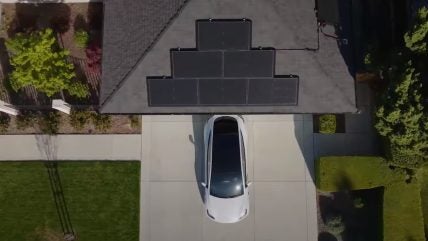
Tesla has opened orders in the US for its Powerwall 3 home battery, nine years after the first-generation Powerwall was launched and nearly eight years after it acquired rooftop solar generation firm SolarCity with the aim of creating “the world’s only integrated sustainable energy company”.
Back then, the company said: “Just as Tesla has demonstrated the superiority of electric vehicles, the solar roof and Powerwall 2 will transform energy generation and storage.”
Its thinking, not unreasonably, was that by pairing its storage offer with solar generation it could boost the value of each.
However, while energy storage deployments have grown steadily – and significantly from 2022 to 2023, to the tune of 125% – the same cannot be said of Tesla’s solar deployments.
Fourth-quarter solar deployments dropped by a notable 59% from 2022 to 2023 and, indeed, have been on a downward quarterly trend since a post-pandemic peak of 106MW in Q2 2022. The last time before that they were as high, though, was in 2017.
In fact, the bigger picture is that Tesla’s annual solar deployments were at their highest in 2016 when it acquired SolarCity – and they were higher still at SolarCity the year before that.
In its 2023 Q4 report, Tesla put its solar woes down to broader “downward pressure on solar demand”, an argument that’s not without merit. As the Financial Times noted in November last year, interest rates, cost inflation, regulatory changes and supply chain issues have made for a tough time of things at US solar firms since 2021 – but the FT also pointed to comments by Elon Musk indicating that employees had been taken off Tesla’s solar work to focus on its cars.
Francesca Gregory, energy transition analyst at GlobalData, comments: “Tesla’s energy storage segment continues to become an increasingly promising business area. The company’s latest earnings indicated strong growth, with the company deploying over 14GWh of battery energy storage throughout 2023. This growth has caused Tesla to emerge as a pre-eminent technology provider within the energy storage market, with Tesla being ranked first in this category according to GlobalData’s company rankings.
“The company accounts for over 6.6GW of energy storage capacity across active and upcoming projects in terms of technology provision, a number that will likely only increase with the opening of additional production facilities such as its Shanghai megapack battery plant in Q4 2024.
“Meanwhile, Tesla’s status within the solar market has stagnated. Despite its ambition to ‘eliminate fossil fuels’ within part three of its master plan released in April 2023, the company’s solar roof product has faded into the background of its wider corporate strategy. An analysis of GlobalData’s company filings database reveals a notable absence of Tesla’s solar roof within product mentions. In the context of high inflation rates and supply chain bottlenecks within the wider solar market, the company appears to be struggling to ramp its solar production volumes.”



